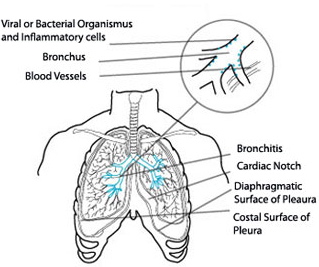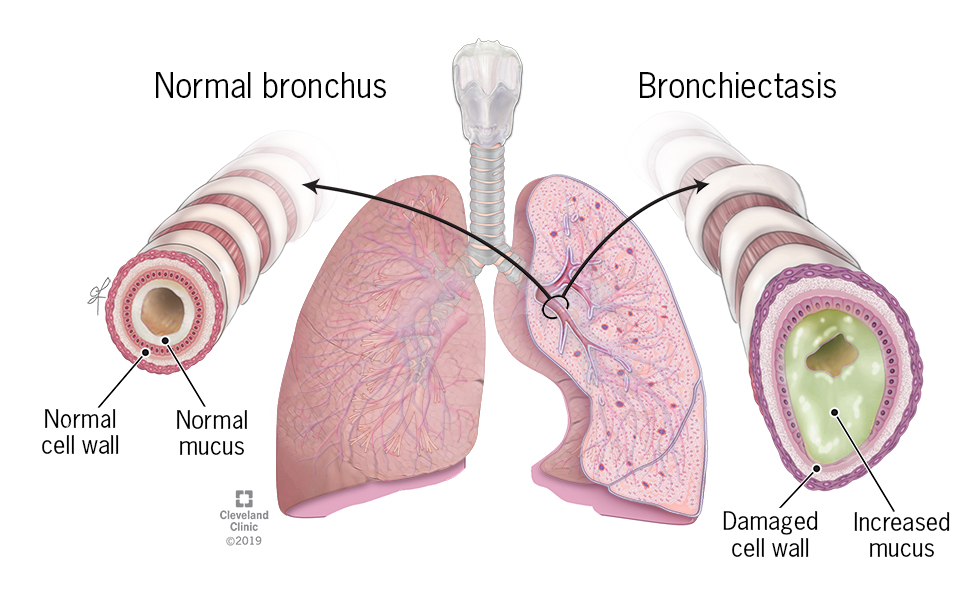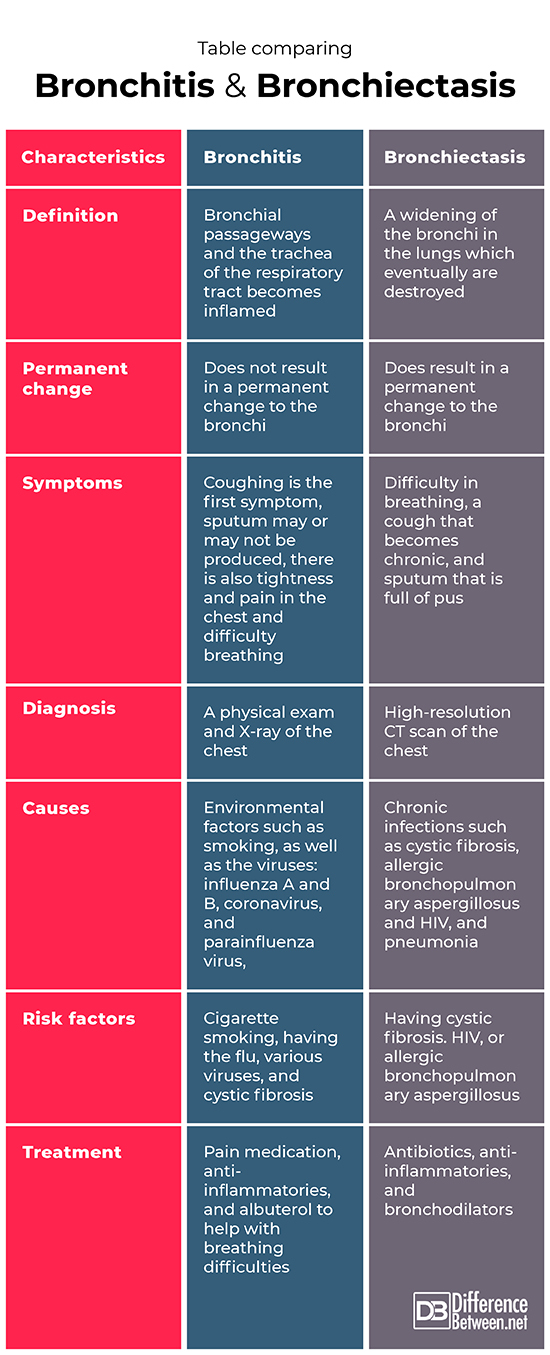Difference Between Bronchitis and Bronchiectasis
Bronchitis is an inflammatory disorder of the trachea and bronchial tubes. Bronchiectasis is a disorder in which the bronchi widen and become destroyed due to infection.

What is Bronchitis?
Definition:
Bronchitis is the illness that occurs in which the breathing tubes, the trachea (windpipe) and also the bronchi are in a state of inflammation.
Symptoms:
Bronchitis typically begins with a cough that eventually may produce sputum. There is also often a pain in the chest and a feeling of tightness and dyspnea is often present. The breathing passages are often very congested. In addition, the condition usually lasts for over a week and may even take up to 21 days for a person to fully recover from.
Diagnosis and causes:
A clinician can diagnose bronchitis in a person by doing a physical exam and noting the symptoms. Listening to the chest and also doing a chest X-ray may be helpful in ruling out other possible causes of the chest problems. Most often the condition is the result of a viral infection particularly associated with influenza type A and B, and rhinovirus. There are other viruses that can lead to bronchitis, including the parainfluenza and coronavirus. Environmental factors such as smoking can result in bronchitis as can having the illness cystic fibrosis.
Risk factors and treatment:
Having some type of illness such as influenza or cystic fibrosis are risk factors for getting bronchitis as is being a smoker. Generally, the condition is treated symptomatically with pain killers and bronchodilator medications such as albuterol which helps with the congestion. Acute bronchitis can eventually lead to pneumonia if untreated.

What is Bronchiectasis?
Definition:
Bronchiectasis is the condition in which the larger sized bronchial tubes in the lungs become wider and are eventually destroyed.
Symptoms:
Having a cough that will not go away and also coughing up pus-filled sputum are symptoms of bronchiectasis. Some patients may also experience difficulty breathing and have a fever.
Diagnosis and causes:
A physical exam in conjunction with CT scans can help in diagnosing bronchiectasis in a patient. It is important that the scans are done at a high resolution in order to detect the condition. The condition may occur in one or a few spots in the lungs or throughout the lungs. The illness can be caused by allergic bronchopulmonary aspergillosis, cystic fibrosis, and problems with the cilia and disease of the connective tissues. In some cases of focal bronchiectasis, the cause is thought to be pneumonia.
Risk factors and treatment:
Certain chronic infections including cystic fibrosis and HIV infection are risk factors for the development of this condition. The condition allergic bronchopulmonary aspergillosus is also a risk factor for the development of bronchiectasis. Antibiotics may be prescribed and bronchodilators may also be helpful in helping to clear the airways. Anti-inflammatory agents may also help with the inflammation of the bronchi. Untreated bronchiectasis can cause death, particularly in countries of the developing world where medical treatment is limited.
Difference between Bronchitis and Bronchiectasis?
Definition
Bronchitis is the disorder in which the tracheal passage and bronchi become inflamed. Bronchiectasis is the disorder in which bronchi in the lungs widen and become destroyed.
Permanent change
The disorder bronchitis never leads to a permanent change in the shape or structure of bronchi. The disorder bronchiectasis often leads to a permanent change in the shape or structure of bronchi.
Symptoms
The earliest symptom of bronchitis is usually a cough, which may or may not result in sputum being produced. The chest is also painful and feels tight and there is difficulty in breathing (dyspnea). The bronchiectasis often has symptoms of dyspnea, a chronic cough, and production of sputum which is full of pus.
Diagnosis
The diagnosis of bronchitis is usually by physical examination and a chest X-ray. The diagnosis of bronchiectasis is done by looking at a high-resolution CT scan of the chest.
Causes
Bronchitis can be caused by smoking and from viral infections such as those caused by influenza A or B, parainfluenza or coronavirus. Bronchiectasis can be caused by bacterial infections such as pneumonia, and chronic infections such as cystic fibrosis, allergic bronchopulmonary aspergillosus, and HIV.
Risk factors
Cigarette smoking, having the flu, various viruses, and cystic fibrosis are risk factors for developing bronchitis. Having cystic fibrosis, HIV, or allergic bronchopulmonary aspergillosus are risk factors for developing bronchiectasis.
Treatment
The treatment options for bronchitis are the use of pain medication, anti-inflammatories, and albuterol to help with breathing difficulties. The treatment options for bronchiectasis are the use of antibiotics, anti-inflammatories, and bronchodilators.
Table comparing Bronchitis and Bronchiectasis

Summary of Bronchitis Vs. Bronchiectasis
- Both bronchitis and bronchiectasis involve problems with the bronchial tubes.
- Bronchitis also includes inflammation of the trachea.
- Bronchitis and bronchiectasis can also develop as a result of cystic fibrosis.
- Bronchitis is an inflammatory condition that does not result in deformity of the bronchial tubes.
- Bronchiectasis often results in permanently altered bronchial tubes.
- Both conditions can be treated with pain killers and bronchodilator medications.
- Difference Between Rumination and Regurgitation - June 13, 2024
- Difference Between Pyelectasis and Hydronephrosis - June 4, 2024
- Difference Between Cellulitis and Erysipelas - June 1, 2024
Search DifferenceBetween.net :
1 Comment
Leave a Response
References :
[0]Korah, Basak. “Bronchiectasis”. Merckmanuals. Merck & Co., 2018, https://www.msdmanuals.com/professional/pulmonary-disorders/bronchiectasis-and atelectasis/bronchiectasis
[1]O'Donnell, Anne E. "Bronchiectasis." Chest 134.4 (2008): 815-823.
[2]Sethi, Sanjay. “Acute bronchitis”. Merckmanuals. Merck & Co., 2018, https://www.msdmanuals.com/professional/pulmonary-disorders/acute-bronchitis/acute-bronchitis
[3]Image credit: https://www.clevelandclinic.org/healthinfo/ShowImage.ashx?PIC=4400
[4]Image credit: https://commons.wikimedia.org/wiki/File:Acute-bronchitis.jpg

Is Bronchiectasis a known risk factor for developing severe symptoms of covid?
I am asking because i have this condition but could not find any information / studies that link this condition with severe covid symptoms.